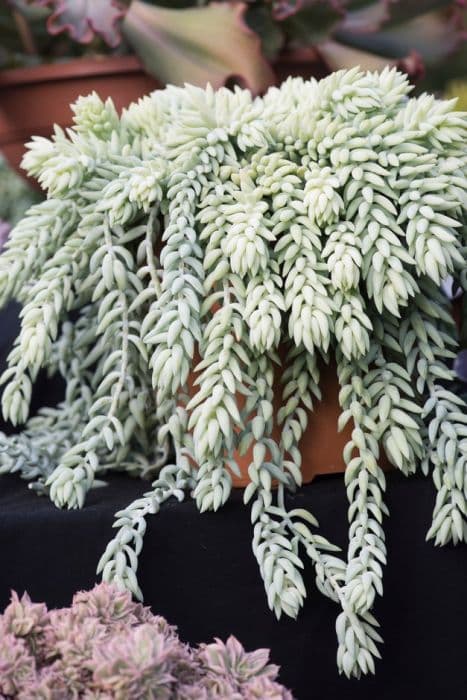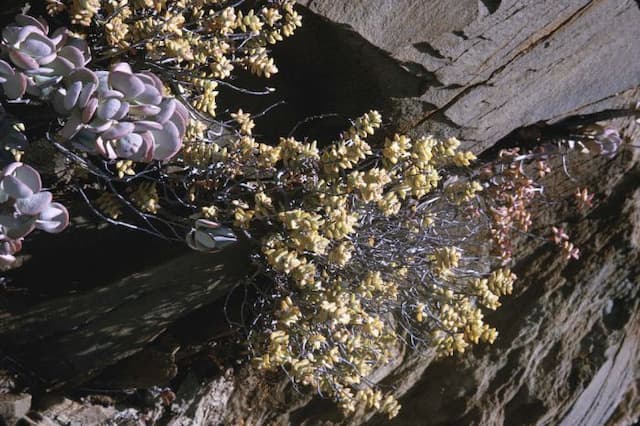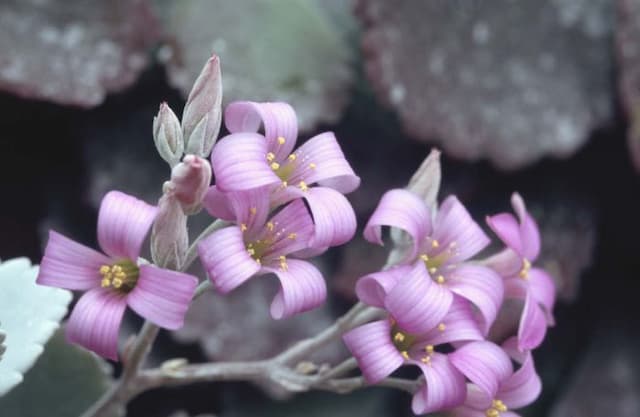Burro's Tail Sedum morganianum

ABOUT
The most commonly known as the Burro's tail, this distinctive plant has a unique and eye-catching appearance. It is a succulent, meaning it has thick, fleshy leaves that are designed to retain water. These leaves are small, plump, green, and shaped somewhat like jelly beans, giving it a very distinctive texture. They grow in rows upon trailing stems that dangle down from the main plant, making it an ideal choice for hanging baskets where its cascading effect can be fully appreciated. The stems are very full, giving the plant a lush, overflowing look. The Burro's tail can have a bluish-green or slightly grayish-green color, depending on the conditions it is grown in. The leaves are tightly packed on the stems which can give the entire plant a braided appearance from a distance. When well-tended, the plant can produce small, star-shaped flowers, which typically come in a pretty pink or red hue, adding an extra dash of color to its already striking form. The leaves of the Burro's tail are delicate and can easily fall off when the plant is handled or moved, which is something owners need to be careful about. These dislodged leaves can often sprout new plants if they fall on a conducive substrate. Because of its distinctive trailing quality and plush, leafy stems, the Burro's tail is a favorite among enthusiasts for creating a dramatic and lush display in interior and exterior settings.
About this plant
 Names
NamesFamily
Crassulaceae.
Synonyms
Burro's Tail, Donkey Tail, Horse's Tail, Lamb's Tail, Monkey Tail.
Common names
Sedum morganianum.
 Toxicity
ToxicityTo humans
The Burro's Tail is generally considered non-toxic to humans. Ingesting this plant is unlikely to cause more than mild gastrointestinal upset if eaten, and there are no well-documented cases of poisoning from the consumption of this succulent. However, it is always prudent to avoid ingesting any houseplants or other plants when their edibility is questionable.
To pets
The Burro's Tail is also considered non-toxic to pets such as cats and dogs. While it should not be a problem if a pet chews on the leaves, ingestion of plant material can sometimes lead to mild gastrointestinal discomfort, including vomiting or diarrhea, due to the irritation of the digestive tract rather than toxicity. Close supervision of pets around houseplants is advisable to prevent any potential problems.
 Characteristics
CharacteristicsLife cycle
Perennials
Foliage type
Evergreen
Color of leaves
Green
Flower color
Red
Height
1-3 feet (30-90 cm)
Spread
2 feet (60 cm)
Plant type
Succulent
Hardiness zones
10
Native area
Mexico
Benefits
 General Benefits
General Benefits- Easy to Care For: Sedum morganianum, commonly known as the Burro's Tail, is a low-maintenance succulent that requires minimal watering and care, which makes it ideal for busy plant owners or beginners.
- Drought Tolerant: As a succulent, it has the ability to store water in its leaves, making it highly resistant to drought. This is perfect for arid climates or areas with water-use restrictions.
- Aesthetic Appeal: With its unique trailing stems and plump, blue-green leaves, Burro's Tail adds a visually appealing element to any interior or exterior space. It is particularly well-suited for hanging baskets or as a spiller in container gardens.
- Grows Well Indoors and Outdoors: This plant is versatile and can thrive both inside your home and outside in your garden, as long as it is protected from frost and extreme heat.
- Propagation Friendly: Burro's Tail is easy to propagate from stem or leaf cuttings, making it simple for gardeners to create new plants and expand their collection or share with friends.
 Medical Properties
Medical PropertiesThis plant is not used for medical purposes.
 Air-purifying Qualities
Air-purifying QualitiesThis plant is not specifically known for air purifying qualities.
 Other Uses
Other Uses- Sedum morganianum can act as a living curtain or room divider in homes with ample sunlight, hanging from the ceiling in long, draping strands to bring greenery into a partitioned space.
- The plant's succulent nature allows it to be used in drought-tolerant landscaping in areas where water conservation is necessary; it requires little care once established.
- As an educational tool, the Donkey's Tail can be used to teach children and beginners about plant propagation, with its easily detached leaves that can root and grow into new plants.
- They can serve as a creative medium for art installations or living sculptures, particularly in sunny, arid climate art exhibitions due to their unique appearance.
- In outdoor garden settings, Donkey's Tail can be planted to drape over retaining walls or rockeries, providing an attractive cascade of greenery.
- Used in pet-friendly garden areas, they are non-toxic to cats and dogs, making them safe for environments with pets.
- Incorporated into wedding decor, they can add a rustic and whimsical touch to bouquets or table arrangements.
- Utilized in fashion and design for photoshoots or runway decor, offering a lush, exotic backdrop or an accent to avant-garde designs.
- For miniature or fairy gardens, Sedum morganianum's small, cascading form makes it a perfect fit to create tiny, enchanted landscapes.
- As an interior design element in hanging glass globes or terrariums, providing a zero-footprint aesthetic to modern, minimalist spaces.
Interesting Facts
 Feng Shui
Feng ShuiThe plant Burro's Tail is not used in Feng Shui practice.
 Zodiac Sign Compitability
Zodiac Sign CompitabilityThe plant Burro's Tail is not used in astrology practice.
 Plant Symbolism
Plant Symbolism- Persistence: Sedum morganianum, commonly known as the Burro's Tail, is renowned for its ability to thrive in harsh conditions, symbolizing the ability to persist through challenges.
- Strength: Its robust, fleshy leaves that retain water symbolize strength and resilience.
- Peace: With its trailing habit and soothing green color, Burro's Tail is often associated with tranquility and peace.
- Patience: Burro's Tail grows slowly and teaches patience to those who care for it.
- Protection: The dense foliage of Burro's Tail is believed to offer a form of protection, symbolizing safety and shelter.
- Prosperity: In some cultures, succulents like the Burro's Tail are seen as symbols of wealth and prosperity due to their lush and abundant growth habits.
 Water
WaterThe Burro's Tail, or Sedum morganianum, is a succulent that should be watered thoroughly, allowing water to drain freely, and then left to dry out completely before watering again. Generally, this means watering every 1-2 weeks during the growing season, and less often in the winter months, roughly once a month or when the soil is dry to the touch. When you water, aim to provide enough water so that it runs out of the drainage holes of the pot—this could be around 16 ounces for smaller pots, or up to a gallon for larger containers, depending on size.
 Light
LightFor the Burro's Tail, bright but indirect light is ideal. It thrives in a spot where it can receive plenty of light without being exposed to direct, harsh sunlight that could scorch its leaves. A location near a south or east-facing window covered with sheer curtains would be suitable to filter the light.
 Temperature
TemperatureThe Burro's Tail prefers temperatures between 65 and 75 degrees Fahrenheit. However, it can tolerate a range down to about 40 degrees Fahrenheit but should not be exposed to frost. Avoid placing the plant in areas where temperatures could drop below this range during the cold season.
 Pruning
PruningPrune the Burro's Tail to maintain its shape, remove dead or damaged stems, and encourage fuller growth. The best time for pruning is early spring before the active growing season begins. Occasional trimming is generally adequate, removing only what is necessary to shape the plant or get rid of unwanted growth.
 Cleaning
CleaningAs needed
 Soil
SoilBurro's Tail thrives in a mix consisting of potting soil, coarse sand, and perlite to ensure excellent drainage, targeting a slightly acidic to neutral soil pH of around 6.0 to 7.5.
 Repotting
RepottingBurro’s Tail should be repotted every 2 to 3 years or when the container becomes root-bound or the soil exhausted.
 Humidity & Misting
Humidity & MistingBurro's Tail prefers average indoor humidity levels, around 40-50%, and does not require any special humidity considerations.
 Suitable locations
Suitable locationsIndoor
Place Burro’s Tail in bright, indirect light and well-draining soil.
Outdoor
Keep Burro's Tail in bright shade and protect from afternoon sun.
Hardiness zone
10-11 USDA
 Life cycle
Life cycleBurro's Tail, or Sedum morganianum, typically starts its life cycle when seeds are sown in well-draining soil with exposure to bright, indirect light. The seeds germinate and develop into small seedlings with fleshy leaves, a characteristic of many succulents. As it matures, the plant's distinctive trailing stems grow longer and begin to produce more leaves, which are blue-green, cylindrical, and tightly packed like a donkey's tail. Throughout its growth, it requires minimal water due to its drought-resistant nature. Burro's Tail may bloom in summer, producing small, star-shaped flowers at the tips of the stems, although flowering is rare in cultivation. Over time, older stems may become woody, and leaves may drop but can root to form new plants, completing its life cycle through vegetative propagation.
 Propogation
PropogationPropogation time
Spring-Summer
Propogation: The most popular method of propagation for Sedum morganianum, commonly known as the Burro's Tail, is through stem cuttings. Best done in the spring or early summer, this process involves taking a stem cutting about 2 to 4 inches (5 to 10 cm) long, removing the lower leaves, and allowing the cut end to callous over for a few days. Once the end is calloused, the cutting can be placed in well-draining soil and watered sparingly until roots develop. After a few weeks, when the cutting has established roots, it can be treated as a mature plant, with regular watering as needed. This method is effective due to the plant’s natural ability to root easily from stem segments.









